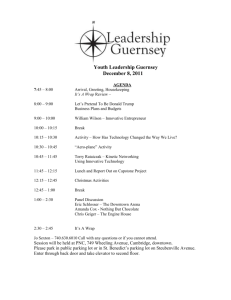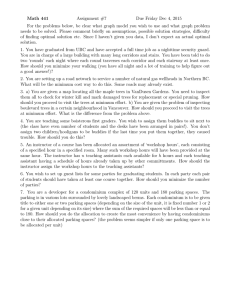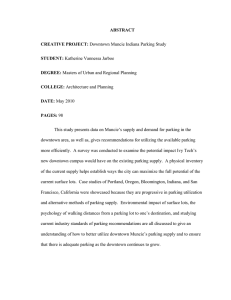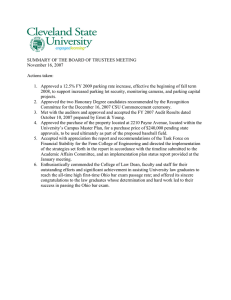Urban Forestry Implementation: A look at Muncie, IN by
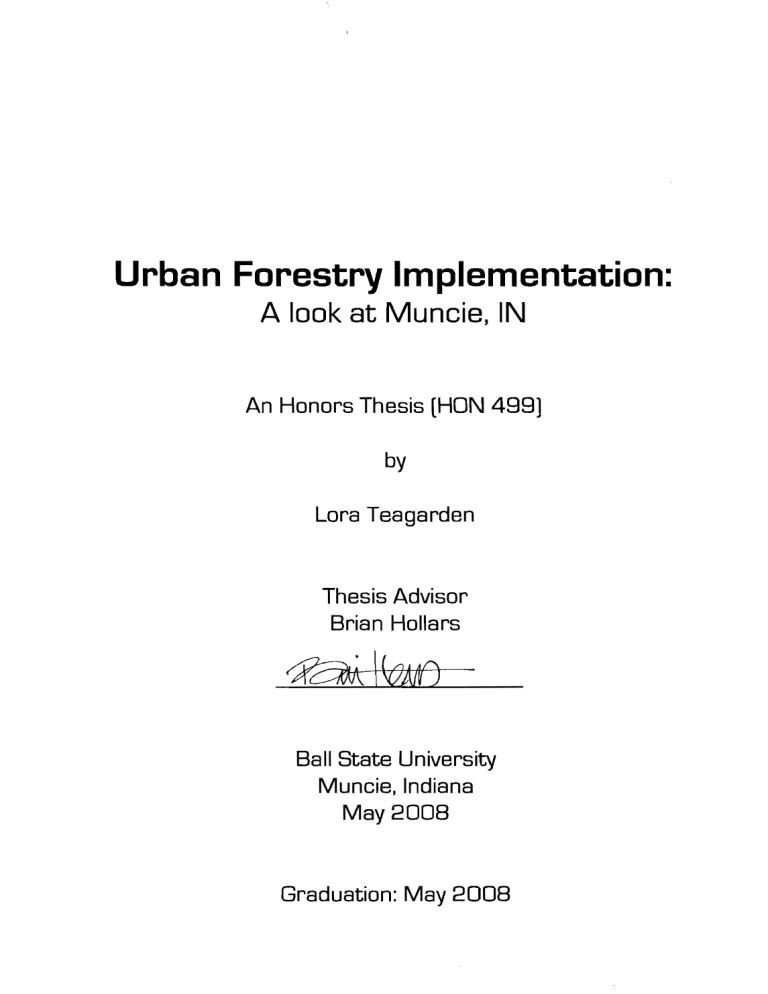
Urban Forestry Implementation:
A look at Muncie,
IN
An Honors Thesis [HON 499]
by
Lora Teagarden
Thesis Advisor
Brian Hollars
Ball State University
Muncie, Indiana
May 2008
Graduation: May 2008
; 1'1:;'
LD d
L} ,
::Table of Contents::
I. Abstract
II. Acknowledgements
III. Parking Study
A. Capacity and Use
B. Past, Present, and Future
C. Parking Proportion Example
IV. Urban Forestry Case Studies
V. Capabilities for Downtown Muncie
A. How
B.
What
C. Time-frame
D. Cost
E.
Benefits
1
::Abstract::
Sustainability and global awareness are more important issues in today's world than ever before. Books about sustainability, products, definitions, awards, aspects of reuse, political parties and organizations, lobbying groups, companies, scientists, and neighbors; everyone and everything is involved. More specifically, every car company is constantly coming out with the "newer and better" hybrid or "green" vehicle. Cars and products do not matter, however, if we do not take a look at our surroundings and, to use an over worn phrase, "increase the green" so that places [neighborhoods, downtowns, streets, sidewalks, and parking lots] work more congruently with people, things [cars, technology, and plant life], and the environment.
This thesis looks at the possibility and capability of implementing aspects of urban forestry, a methodology of "re-planting" cities, into an area of Muncie's downtown. Fifty-four square blocks of space in the heart of downtown were studied for parking capacity and green space, as well as howthis has changed over time. Case studies 'from New York, Pennsylvania, California, and Wyoming were studied for the impact of tree and plant life, both aesthetically on a human scale and financially on a practical scale. Percentages and types of green space were studied in comparison to the amount of carbon they were capable of offsetting in relation to the cost of the plant life and maintenance. Books related to urban forestry planning, plant growth, maintenance, and cost were studied to determine the most practical and efficient outcome for an implementation in Muncie.
The final part of the study brought together both the research of Muncie's downtown as well as the information found in the case studies and research.
Ideas for urban forestry in downtown Muncie include increased green space
[both overall and in proportion with parking lot reduction], more/maintenanced walkways, increased number of trees, and porous pavements for parking lot areas; all of which help offset the total carbon footprint of downtown, as well as increase the health of the city and its patrons.
3
I
I
I
I
I
I
I
I
::Acknowledgements::
I would like to thank Or. Cheryl Sove for proofreading my paper and checking it for technical and grammatical errors.
Most of all, I would like to thank my thesis advisor, Brian Hollars, for his help during this past semester, as well as throughout the course of my academic study.
His guidance and expertise in the field of architecture and project management helped me throughout each part of the process of this thesis, from brainstorming to final proofing. I do not think this project would have turned out as well as it has without his constant, gentle push for me to exceed all expectations. Thanks,
Brian.
5
::Parking Study::
The parking research that was undertaken for this study of downtown
Muncie was bounded in the south by the railroad tracks and ran north to Gilbert
St. The east-west border was Madison St. to Liberty St. This space encompasses
54-sqaure blocks of what is seen as "prime" downtown space. Diagram A below shows convenient parking available in red, buildings in blue and green space as green [trees are shown in a darker green).
Walnut
Cha
6 Diagram A
Because most downtown Muncie-goers complain of the lack of parking to a nearby area, it was thought to be crucial first to see how much parking there is actually available. Therefore, the parking lots were studied for their capacity and use type: private or public. In the 54-square block area, the parking space count reached 4,993, not including thirteen gravel lots which were unable to be assessed for capacity, but estimated at an additional 300 spaces. Diagram B [on pg. 6] shows each parking lot, its capacity, and the type of use .
From this information, it is important to see that the need for parking is possibly not as relevant as described by the residents. While the amount of spaces overall is noticably high for the needs of downtown, almost half [2,357] of the spaces are taken up by reserved or office/ government lots and, therefore, unavailable to most patrons. The more pertinent observation, however, is the sheer amount of parking lots and parking spaces within the 54-square block.
It is especially obvious when viewed apart from the buldings and green space.
Diagrams C, 0, and E are parking, building, and green space diagrams shown in
.
·"1 • •
. •. 1 .
.1
I • •
I •
.1
...
.
·!tI1
11111
III • •
-L. -~ - •
-·~I
•
-
•
.
•
-
-
-
-
.... .
• -...
.
.
.11·
" I
I
-
-.
,.
I
L
•
•
I I
I j: <II : .
..
..
.... ., ·I
[ i
_. .10.... r o
'
' • .
.. L j
.. r r··· ····
! I
/
/ .~
. .
~
.
'
.
, , ":
I : . I
. . r
_ _ I
: : ' I I
L
]
Diagram C: Parking Diagram 0 : Building Diagram E: Green
7
Charles
8
Diagram 8
Walnut
1 . Reserved, 50 45 . Reserved, 38 89 . Unknown, 84 [11 on st]
2. Reserved, 22
3. Government, 26
4. Offices, 24
46. Vacant, 40 [42 on st]
47 . Vacant, 99
48. Unknown
90. Unknown, 39
91. Unknown, 65
92 . Unknown, 10
5
6
.
.
Reserved
Reserved
,
,
36
31
49 . Unknown
50 . Offices , 16 [20 on st]
93 . Unknown, 113
94 . Unknown, 4
7. Offices, 19
8. Reserved, 55
9 . Reserved , 37
51 . Reserved
52. Reserved
,
,
53. Offices, 58
31
39
95 . Unknown, 42
96 . Unknown, 18
97 . Unknown
10. Offices , 27
11. Home , 6
54. Unknown
55 .
, 23
Open, 42 [11 on st]
98 . Unknown
99 . Unknown
12 . Government , 14 56 . Reserved, 20 100 . Unknown , 89
13. Offices, 18
14 . Offices , 11
34 . Reserved, 20
35. Unknown, 4
57. Offices, 56 [11 on st]
58. Reserved, 52
1 5 . Offices , 94
16. Government , 28
59. Offices, 24 [11 on st]
60. Offices, 39 [29 on st]
77 . Unknown [11 on st]
103. Unknown, 30
104 . Unknown, 30
1 7 . Offices , 11
18. Offices
21. Res / Off., 76
22 .
, 116
Museum, 125
61 . Reserved, 146
62. Unknown, 14
19 . Home, 19 63. Unknown, 20
20 . Offices , 24 [14 on st] 64. Unknown, 22
65. Res/Off .
, 74
66 . Offices, 50 [11 on st]
105. Unknown, 20
106
107
108
109
.
.
.
.
Unknown, 10
Unknown, 7 [11 on st]
Unknown, 11
Unknow, 34
76 . Unknown
110 . Unknow, 43
23 . Offices, 16 [18 on st] 67 . Unknown, 6
24 . Museum , 233 68 . Offices , 6 [22 on st]
25 . Unknown 69 . Reserved, 52
26 . Offices , 7
27 . Unknown, 29
28. Reserved, 99
29. Government, 11
30 . Offices, 31
31 . Unknown, 36 75 . Offices, 7
111. Unknown, 27
112
113
.
.
Unknown , 35
Unknown, 26 [22 on st]
70 . Offices, 82 [13 on st]
71. Offices , 65 [11 on st]
114 . Unknown, 109
115 . Unknown, 16
72 . Res/Off.
, 152 [11 on st] 116 . Unknown [11 on st]
73 . Off/Gov.
, 101 [22 on st] 11 7 . Unknown
74 . Offices, 10 [10 on st]
32 . Reserved, 60
33 . Unknown
78. Unknown
79. Unknow, 68
101. Unknown (11 on st]
102. Unknown, 8
36. Vacant, 40
37 . Church, 93
38. 1 5 on street
39.47 on street
40. Reserved , 19
80. Unknow, 7
81. Unknown, 21 [11 onst]
82. Unknown, 20
83. Unknown , 12
84 . Unknown, 47
41. Open , 30 [11 on st]
42 . Open, 89 [11 on st]
85 . Unknown , 11
86 . Unknown, 104
43 . Offices , 45 [22 on st] 87 . Unknown, 99
44 . Offices , 35 88 . Unknown, 112 [22 on st]
9
.-
..
-
•
,..
-
.,
-
I
•
1_..1
...
-
I
~-
-
-
.
•
-
I_
-
.
r
I
-
.
J.
•
\
-
•
.
I
'I
I I
-.-'&'-' -
.I'
- -
•
Diagram F: 1961
I
I
To understand the parking capacity as it is today, it is necessary to know where it once was. In researching previous parking studies from the Muncie Metropolitan
Plan Commission Office, diagrams of parking lot massing from prior years were found. These five diagrams [F-J) show parking density from 1961 to the present.
As the 20th century continued toward the millennium, the increase of and importance placed on technology continued at an exponential pace. It was no longer odd for families to have 2, 3, or 4 cars and, therefore, places for these cars increased as well.
-
-
.1.1 I
'I
."1_..1 - . •
I I I · . , •
• -
-.
"';J.
-
- • . _ .
• I
-
"
II b.-: , -•
.&."
1;1 -••
.-:
-
111
• .1'
III
•
~
•
•
Diagram G: 1974
I ,
Because of this, it is easy to see the influence had on
Muncie's downtown over time .
While we continue to search for the latest technology in every aspect of life. we have also begun to realize that our previous quest for technology and a lifestyle of convenience have been problematic in terms of environmental damage and downtown aesthetic life.
'I I I.r •. • .
-
-
l
... I _
• • u I
;;.
•
I
•
-. 1.1.
• I ,
_
."
1 b.-: , -•
.&.
' "
\I.
I
• . . . . . I
I
•
- -
•
• •
Diagram H: 1982 i~1 r..1 : ..
11.;'.
'
'I
. . , .
-
.1.1 I
,.....
- • .I.J
I '
- • • • I~ .
I_
II
•
1-
_
1
~.-: iii
·
. . •._
•
;
.. , ... .&.
i .
.I:.J
~
I
I
' ,,
I
;
:
:
&'1-••
1 11 ~
•
•
Diagram I: 1996 Diagram J: 2007
1---
L
I .
'
The remainder of this booklet shows the research of urban forestry in other areas as well as the implementation process for Muncie. Urban forestry involves the new planting or re-planting of downtown blocks and streets with hearty shrubs and trees. Most cities opt to create tree-lined streets before taking away parking spaces, but many places have shown that the minimal removal at a rate of one to five or one to six increases the positive effects of the downtown forestry with minimal impact on parking.
Given this scenario, if one of every six parking spaces were taken away for the use of green space, this would leave 4,161 spaces to be used, while the green space would increase by 166,400sq.ft [832 parking spaces). If one of every five parking spaces were taken away for the use of green space, 3,995 would be left for vehicular use. The green space would increase by 199,600sq.ft. While this would cause minimal impact on parking spaces available, the increased green space would cause even more of a reduction of carbon and air pollution [among other factors discussed later). The diagrams below [K and L) show the current state of green space in Muncie and the possible future state of urban forestry at the proportional rate of one to six.
I I
r / · .. ..
/
.}
· ;
; ~
..
. : .
~
.,. I'
.
.
..
. r
J
.
.
_
.
L
•
]
_, I
- Diagram K: 2007
11
::Case Studies::
New York, Philadelphia, San Francisco, and Casper, Wyoming studies by the USDA [US Department of Agriculture) and Forest Service using the UFORE
Model [Urban Forest Effects, www.ufore.org ) were researched to find the cost of tree maintenance in comparison to the positives of a tree in a city: carbon storage and removal, air pollution removal, and energy cost [reduction). A graph has been produced below for easy reference and understanding of the important quantities found in the studies.
New York City
Philadelphia
San Francisco
Casper, WY
# of Trees Struct. Value Carbon Storage
5 .
2 m $5.2b
Carbon Rem.
1 .
35m; $24.9m 42 .
3k tons; $779k1yr
2 .
1m
669k
123k
$1.8b
$1.7b
$243m
530k tons; $9.8m 16 .
1 k tons; $297k1yr
196k tons; $3.6m 5.2k tons; $95k1yr
37ktons;$689k 1 .
2k tons; $22k1yr
Air Pollution Rem . Energy Cost Red . Fossil Fuel Plant Carbon Red. Trees/Acre
New York Ci~ 2.2k tons; $10 .
6mfyr $11.2m/yr 9.1ktons; $167k1yr 26.4
Philadelphia 802 tons; $3.9m/yr $1.18m/yr 770 tons; $14.4k1yr 25.1
San Francisco
Casper, WY
260 tons; $1 .
3mfyr
50 tons; $249k1yr
Unknown
$26.7k1yr
Unknown
Unknown
22 .
5
9 .
1
12
For numerical purposes, a single tree ' s structural value is found by dividing the total number of trees into the total structural value and a single tree's carbon storage is found by dividing the total number of trees into the total tonnage of carbon stored, etc.
This means that, on average, each tree's structural value is $1,105 . It stores one quarter of a ton of carbon at the value of $4 and annually removes
.OOB of a ton [16Ibs) each year at the value of 14 cents per year. It removes
.0004 of a ton [.Blb) of air pollution each year at the value of $1 .
9B per year. It saves $1.67 in building energy cost reduction each year. It removes .001 of a ton
[2Ibs) of carbon from fossil fuel plants at the value of 2 cents each year .
While this doesn't seem like very much help at the value per tree, the graph information above shows how precious each tree is to the total sum. Air pollution alone can lead to health problems, damage to landscape materials and ecosystems, and reduced visibility. In terms of carbon storage, as a tree grows,
it is capable of holding and storing more carbon than the year before, thereby increasing the temperature reduction and allowing buildings to work more efficiently . Other benefits that cannot be so easily prescribed as numerals are air tempertature reduction, absorption of ultraviolet radiation, improved water quality, reduced noise, improved human comfort, increased property value, improved physiological and psychological well-being, aesthetics, and community cohesion .
With the help of these case studies, the positive impact of an urban forest becomes more apparent. While some of the positives of plant life in an urban setting cannot be calculated for a numerical value, the outcome is not hard to notice. A downtown with a more comfortable and relaxing feel. due to urban forestry, will be more frequently visited than a similar downtown lacking plant life.
The air will be/is healthier, the summer temperature is reduced, and the view is more pleasing to the eye. Overall, the implementation of urban forestry has been shown to be a step in the right direction towards a healthier environment.
13
14
::Downtown Muncie::
How
In
Urban Forest: Comprehensive Management,
Gene Grey states that "the challenge of comprehensive management is to recognize the complexity of the total urban forest and to put in place and operate a system that meets the needs of trees and related organisms, structures, and people," [1978). The first part of this system is the setup/ delegation of an organization or authority to oversee the process and continued maintenance of the urban forest. Depending on the scale of this forest or city, the authority could be placed in the public works sector because most of the later maintenance might fall there. Whoever is chosen to head the supervision of the urban forest should have the four main forestry needs covered : planting, maintenance, protection, and removal.
An analysis, similar to [but more in-depth than) Diagram E, should first be made. This should determine all aspects of the physical environment, from trees and species [and their health) to location and ownership/responsibility. It is important in this process, as well as the new-plant process, to determine if the plant life will take an active or passive role in terms of its surroundings: as this will affect the amount of maintenance required [more for active) for the plant[s). A budget should be drawn up using government money, grants, fundraisers, or all of the above to fund the new design and future maintenance. A long-range plan can then be created to fit the wants and needs as well as the given budget. This plan will state the overall mission as well as define objectives and priorities. The plan should also include the previous analysis, the future vision, the process to get there, and everything required to implement the desired outcome.
What
TREES: In the previous plan. trees (and shrubs) should be chosen based on the city location (latitude. continent. etc) as well as the location w i thin the city.
Knowing this will help decide the types and species of trees to be used for efficiency and lifespan. Certain trees that would do well in the Muncie area are as follows:
Honey Locust : native to eastern North America. generally not high risk in pest potential. fast growth. tolerates urban conditions
(compact soil and road salt) and heat
Blackgum: able to grow in midwest. able to exist on unfavorable sites. can handle low water amounts
Flowering Dogwood: attracive ornamental tree . grows well in eastern United States. sometimes home for smaller wildlife
Gray Birch : fast growth. adapts to soils with both poor and excessive drainage. competitive for nutrients
Sweetgum : good windbreak tree. fast growth. adapts to wide variety of sites . native to east-central United States
Green Ash : good windbreak tree. native to eastern North
Amer·ica . slow growth. easy to establish
There are obviously many more trees that could be chosen based on want/ need and cost . Those listed above have either been shown to be hearty or have worked well previously as street/parking lot trees.
PAVEMENT: Porous pavements can also be used in parking lots to not only create a more effective drainage system that is better for the environment but to also maintain the wear and tear of vehicle traffic . These types of pavements will also allow trees and other plant life to grow healthier and longer.
15
16
Time-frame
Depending on budgeting needs or availabilities, the initial planting time-frame can be at varying speeds/length. The planning portion of the schedule should take up a substantial part of the initial phase and can be a time when monetary resources are being searched for and acquired. The secondary, and longer, portion of the time-frame involves the continued maintenance and protection of the trees involved. Because trees will need to be replaced [if they die] or added as time goes on, this portion of the time-frame can be seen as a continuous cycle.
Cost
Cost is broken down to the types of trees, location/ site costs, maintenance, protection, and salary for those working to care for the urban forest. While most people tend to think that the "protection" aspect would involve a rather large sum, due to vandalism, they would be surprised to find out that most trees do not die from vandalism, but from improper maintenance [lack of/over watering, nutrient deprived soil, wounds from trimming and hedging, etc). While certain trees cost more than others, their lifespan, tree canopy percentage/style, heartiness, and other such factors should not be ruled out in the varied price. More often than not a less expensive tree will work less efficiently and need more care in the long run.
Because porous pavements are a relatively newer technology, the average cost is slightly higher than traditional asphalts . This consideration is similar to that of a cheaper or more expensive tree. The buyer will get more environmental results with the slightly added expense of a porous pavement; which is not only better for the environment, but also allows the trees to grow healthier.
I
I
I
I
I
I
I
I
I
I
I
I
I
I
Benefits
Many downtowns seem to forget the variety of roles that the trees in an urban environment play. On an environmental scale, the removal of carbon and air pollution from the atmosphere, in any amount, is always a step in the right direction. The cost, and health, benefits of the removal are also great.
On a human scale, the role that the trees play is immense. The owner of a building will enjoy a more economical energy bill when trees are nearby to block cold winter winds and hot summer sun. A passerby will enjoy the trees by the building because of reduced glare, temperature, aesthetic and shade, not to mention the cleaner air he/she breathes because of the trees. The downtown will seem more walk-able and inviting to the passerby when the streets have trees instead of a "concrete jungle" grid lacking plant life.
As every person becomes more environmentally conscious, these ideas can be more easily achieved and improved. While nothing can entirely negate the carbon footprint of a person's life, each step, from helping fund the purchase of a tree to walking to work, is one step to a healthier world.
17
I
I
I
::Works Cited::
Bradley, Gordon A. Urban Forest Landscape: Integrating Multidisciplinary
Perspectives. Seattle and London: University of Washington Press, 1995.
Bradshaw, Anthony, Hunt, Ben, and Walmsley, Tim. Trees in the Urban
Landscape: Principles and Practice. London: E & FN Spon, 1995.
Delaware- Muncie Metropolitan Plan Commission. Seeking Balance: A Sustainable
Role for Transportation in Downtown Muncie. Muncie: MPO, 1998.
Grey, Gene W., and Deneke, Frederick J. Urban Forestry. New York: John Wiley and Sons, 1978.
Kuser, John E. Handbook of Urban and Community Forestry in the Northeast.
New York : Kluwer Academic/Plenum Publishers, 2000.
Lipkis, Andy and Katie. The Simple Act of Planting a Tree. Los Angeles: Jeremy P.
Teacher, Inc., 1990.
Miller, Robert W . Urban Forestry: Planning and Managing Urban Greenspaces.
New Jersey: Prentice Hall, 1997.
Moll, Gary and Ebenreck, Sara. Shading Our Cities. Washington, D.C.: Island
Press, 1989.
Urban Forest Effects Model. Unknown. US Department of Agriculture and
Department of Forest Service. 20 March 2008 <www.ufore.org>.
